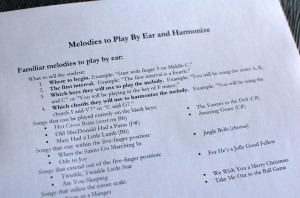Now to the heart of the discussion! We’ve already covered some common obstacles encountered when trying to incorporate improvisation, and we’ve briefly discussed the history and the value of improvisation. Now let’s discuss a practical way to incorporate improvisation (non-jazz improvisation, in particular) into the piano lesson.
There are 4 steps in the method I am proposing for incorporating improvisation. I had originally planned to post all 4 steps into one post, but the post would be too lengthy.
 So the topic “Incorporating Improvisation” will be divided into 4 separate posts:
So the topic “Incorporating Improvisation” will be divided into 4 separate posts:
- Develop Related Skills
- Create an atmosphere conducive to improvisation
- Use improvisation as a way to introduce new concepts
- Improvise using a combination of learned concepts
Today, we are discussing step 1: Developing Related Skills.
1. Develop Related Skills
In order for incorporation of non-jazz improvisation to be successful, it is extremely helpful for the student to have developed (or be developing) the following skills:
- Playing by ear — will help the student learn how to play what they hear in their mind’s ear, which is essential to improvisation. For a list of melodies to assign students to practice playing by ear, see the Melodies to Play By Ear and Harmonize pdf, available on the Printables > Other Resources page (scroll down to the M’s).
- Harmonization — will help increase the student’s understanding and awareness of harmonic progressions. Even young beginners can harmonize, using just a single-note bass line of the tonic and dominant pitches. For a list of melodies to assign students to practice harmonizing, see the Melodies to Play By Ear and Harmonize pdf, as mentioned above.
- Transposition — will help students understand how keys and key signatures work, so they can improvise within a particular key, and in a number of different keys. Also helps them understand the difference between major and minor, which they can utilize to create different moods in their improvisations.
- 5-finger patterns, scales, arpeggios, cadence patterns, chords in all inversions, etc. (in all major and minor key signatures) — These are exercises that teachers should already be assigning their students, but I think it’s important to bring them up here in connection with improvisation. If the student still struggles with getting around the piano, improvisation will likely be difficult. The more comfortable the student is with playing various configurations of notes on the piano, the easier it will be for the student to “get beyond the notes” and focus on things like expression, mood, and telling a story with their music.
Each of the skills mentioned above can be taught gradually to the student, in accordance with their level of playing. For example, beginner students should be assigned simple tunes to play by ear that can be played entirely on the black keys, and gradually work up to tunes that can be played on the white keys.
Coming up next: part 5b of Incorporating Improvisation into the piano lesson.
Be sure to check out the rest of the posts in the series:
Series: Incorporating Improvisation into the Piano Lesson
- Creativity in the Piano Lesson – Introductory musings.
- Top 3 Obstacles when Teaching Improvisation
- A Brief History of Improvisation
- The Value of Improvisation
- Incorporating Improvisation:
- part a (now viewing)
- NEXT: part b
- part c (coming soon)
- part d (coming soon)
- 3 Benefits of Incorporating Improvisation (coming soon)

